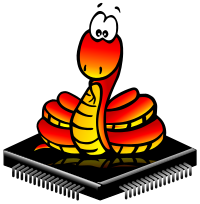MicroPython
 | |
| Family | Python |
|---|---|
| Designed by | Damien George |
| First appeared | May 3, 2014 |
| Stable release | 1.8.7
/ January 8, 2017 |
| Typing discipline | duck, dynamic, strong |
| Implementation language | C (programming language) |
| License | MIT license[1] |
| Website | micropython |
| Influenced by | |
| Python | |
MicroPython [2] is a software implementation of the Python 3 programming language, written in C, that is optimized to run on a microcontroller.[3][4] MicroPython is a full Python compiler and runtime that runs on the micro-controller hardware. The user is presented with an interactive prompt (the REPL) to execute supported commands immediately. Included are a selection of core Python libraries, MicroPython includes modules which give the programmer access to low-level hardware.[5]
MicroPython, was originally created by the Australian programmer and physicist Damien George, after a successful Kickstarter backed campaign in 2013.[6] While the original Kickstart campaign released MicroPython with a pyboard microcontroller, MicroPython supports a number of ARM based architectures.[7] MicroPython has since been run on Arduino,[8][9] ESP8266,[10] ESP32,[11] and Internet of things[12][13] hardware. In 2016 a version of MicroPython for the BBC Micro Bit was created as part of the Python Software Foundation's contribution to the Micro Bit partnership with the BBC.[14]
The source code for the project can be found on GitHub.[15]
References
- ^ George, Damien P. (4 May 2014). "micropython/LICENSE at master · micropython/micropython". GitHub. Retrieved 11 February 2017.
{{cite web}}: Cite has empty unknown parameter:|dead-url=(help) - ^ MicroPython
- ^ Venkataramanan, Madhumita (6 December 2013). "Micro Python: more powerful than Arduino, simpler than the Raspberry Pi". Wired. Retrieved 15 December 2016.
- ^ Yegulalp, Serdar (5 July 2014). "Micro Python's tiny circuits: Python variant targets microcontrollers". InfoWorld. Retrieved 15 December 2016.
- ^ "Software". http://micropython.org/.
{{cite web}}:|access-date=requires|url=(help); External link in|website=|url=(help) - ^ "Micro Python: Python for microcontrollers". Kickstarter. Kickstarter. Retrieved 15 December 2016.
- ^ Beningo, Jacob (11 July 2016). "Prototype to production: MicroPython under the hood". EDN Network. Retrieved 15 December 2016.
- ^ Horsey, Julian (12 October 2016). "Pyduino Arduino Based Development Board That Supports MicroPython (video)". Geeky Gadgets. Retrieved 15 December 2016.
- ^ Beningo, Jacob (6 April 2016). "Getting Started with Micro Python". EDN Network. Retrieved 15 December 2016.
- ^ Williams, Elliot (21 July 2016). "MICROPYTHON ON THE ESP8266: KICKING THE TIRES". Hackaday. Retrieved 15 December 2016.
- ^ "MicroPython ported to the ESP32". Github. Retrieved 8 March 2017.
- ^ "FiPy – The world's first 5-network IoT dev board". Kickstarter. Retrieved 15 December 2016.
- ^ "Pycom Incorporating Sequans LTE-M Technology in New 5-Network IoT Development Board". Business Wire. 22 November 2016. Retrieved 15 December 2016.
- ^ Williams, Alun. "Hands on with the BBC Micro-Bit user interface". ElectronicsWeekly.com. Retrieved 8 July 2015.
- ^ on GitHub

